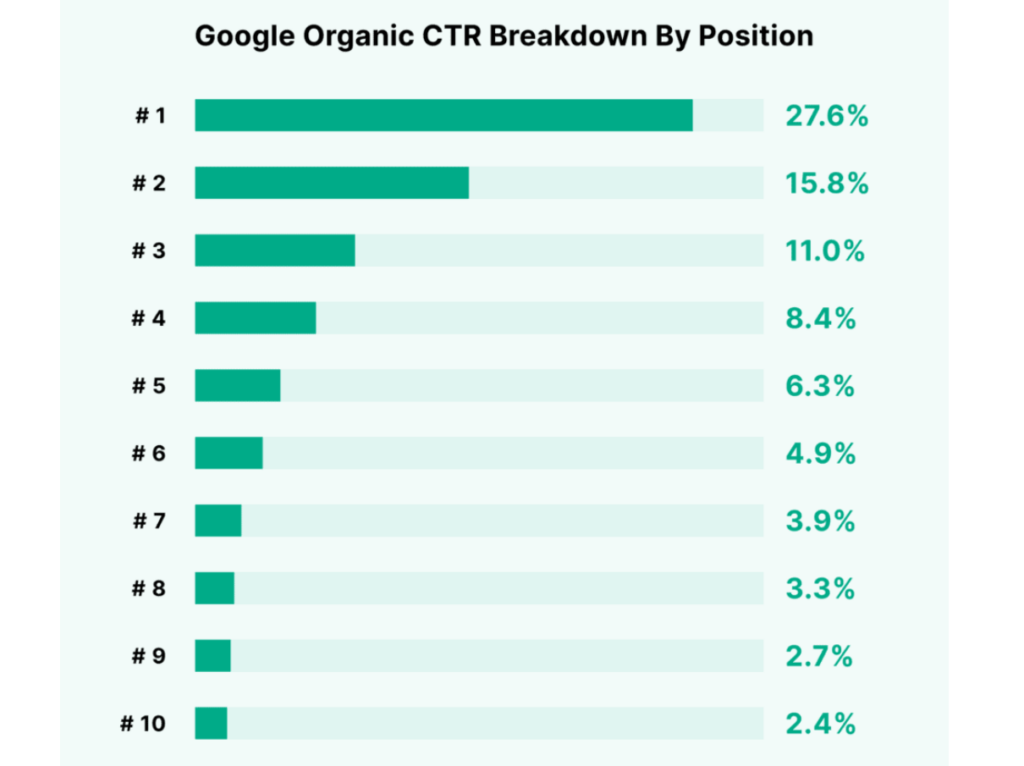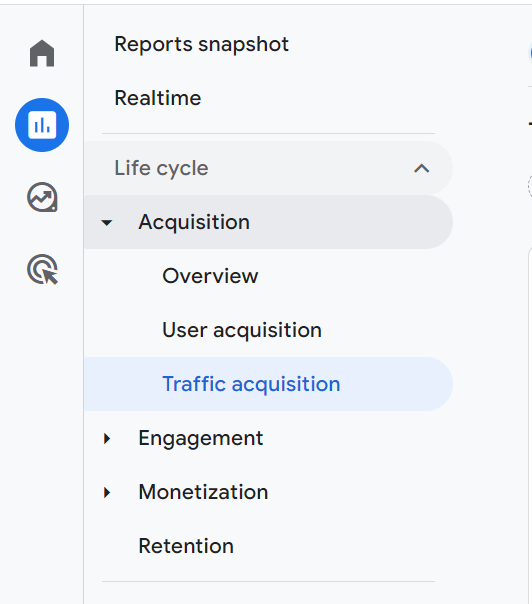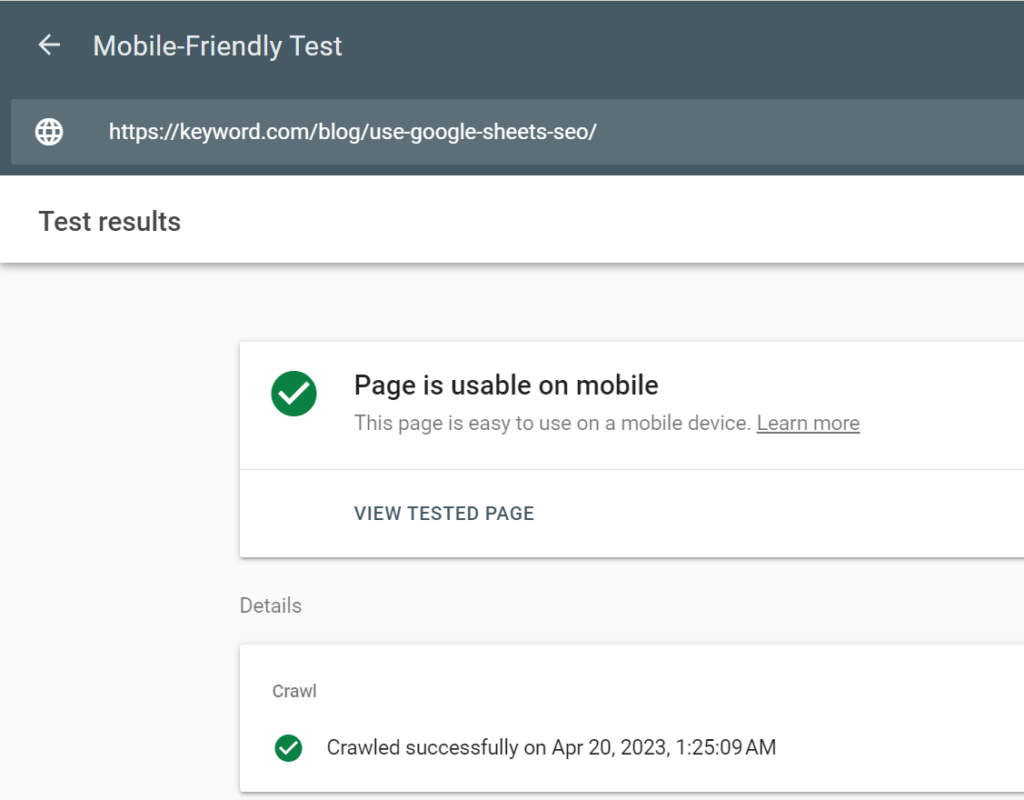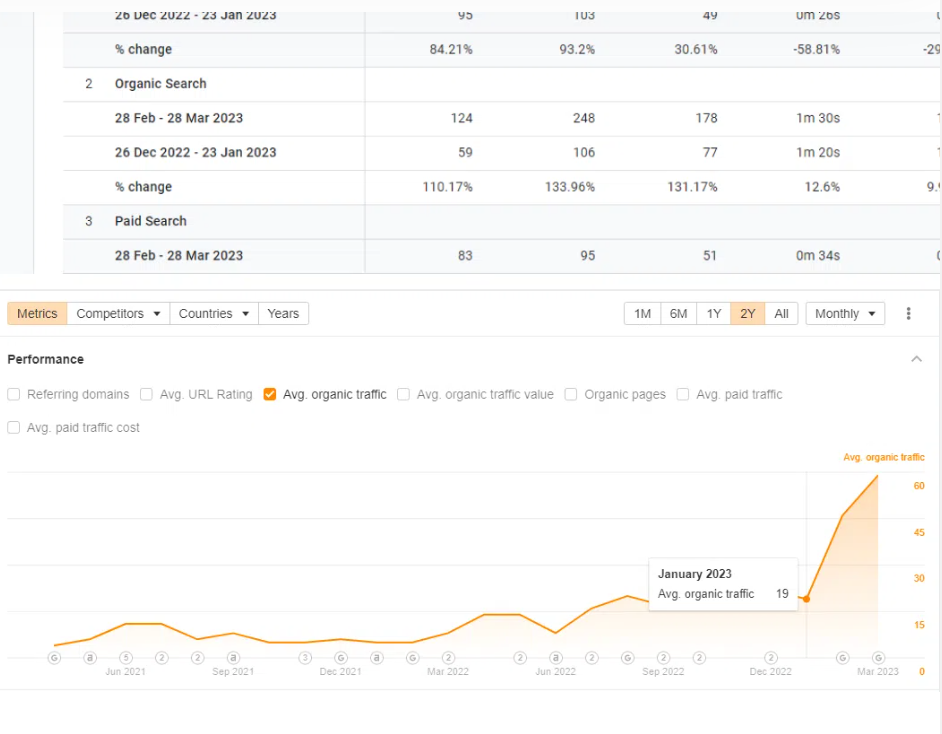It’s all fun and games when you’re ranking on the first page of Google—until you’re not.
Now, you’re dropping in rankings, clicks, and visitors, and the page struggles to attract more traffic and customers. Simply put, there is a reduction in the page’s search visibility.
In cases like these, you need quick SEO tweaks that can turn the needle and make a difference in your ranking. After all, you want your content to be seen whenever Google users search for those pages’ primary keywords.
This article will discuss proven hacks from experts in the industry to increase your search visibility. Before we delve into the details, we should have an overview of search visibility.
What is Search Visibility?
Search visibility, otherwise known as SEO visibility or search engine visibility, refers to the extent to which a website is visible and prominent in search engine results pages (SERPs) for specific search terms or keywords. It is an important SEO Share of Voice for online businesses and digital marketers as it directly impacts website traffic and customer acquisition.
For example, Backlinko’s Google organic Click-through-rate study shows that pages ranking first on Google have an organic CTR of 27.6%, #2 has 15.8%, and #7 has 3.9%…

If you rank fifth for a particular keyword, your search visibility is 6.3%.
In other words, search visibility measures how well a site’s keywords rank on SERPs.
You can access your site’s visibility score via your Google Analytics or SEO platforms like Keyword.com, SEMrush, Ahrefs, Seobility, and more. Keyword.com, for example, has a share-of-voice feature that provides a fraction of organic traffic in a niche that comes to your website. You can use these keywords and explore how you are ranking for particular topics or clusters.
In addition, the Keyword.com SERP tracker provides details of your keyword rankings on search engine result pages. But without further ado, let’s examine how to improve your SEO visibility.
SEO Tips and Tricks to Increase Your Search Engine Visibility – Experts Share
Before we proceed, it’s important to note that content quality is a crucial ranking factor. Nothing beats publishing quality content focused on satisfying the searchers’ intent.
If you fail on this side, don’t bother going further.
Get back to your site and refurbish your content.
Content published for robots and not humans will struggle to climb the SERPs ladder.
What’s more?
1. Analyze your Google Search Console and Analytics Tool
Google Search Console performance page shows you the total clicks, impressions, average position, and page position within a timeframe. You can figure out the factors responsible for the drop in ranking and make possible adjustments.
Also, you can inspect any URL on your site. To do so, click the URL inspection icon and enter the URL you want to inspect. The Webmaster tool retrieves data from Google Index and provides details about the URL.
How to analyze your site’s traffic on Google Analytics:
- Click the Report icon.
- Under Life Cycle, click Acquisition.
- After the drop-down menu, click Traffic Acquisition, and there you have an overview of your site traffic.
The details from these analyses can help you discover your pages’ ranking issues and fix them.
2. Optimize Relevant Keywords
Identify Keywords You Didn’t Target
“One thing that worked well for me in the past is looking at Google’s Search Console (which is free) and identifying keywords that I didn’t target but are already showing up in Google. The fact that Google already trusts me a little, even if I didn’t use the term anywhere, is a sign that I can rank for it. I can often optimize an existing page for that keyword and see results within week, ” Ruurtjan Pul, nslookup.io
How do you find keywords you didn’t target?
– Go to Google Search Console
– Click ‘Pages’ and click a page you’d like to optimize.
– Set the ‘Date range’ filter to ‘Last 16 months’.
– Click on ‘Average position’ to show the position data.
– Sort the results by position (from large to small)
– Add a filter: ‘Impressions greater than 100’ (you may need to adjust this value for your site)
Search Console then provides a list of keywords it thinks the article may be relevant for but doesn’t rank you high yet.
Target Low-Hanging Fruits Keywords
Adam Berry, Owner of Adam Berry SEO, shares his experience:
“In my experience, a quick-win strategy that has proven to be successful is targeting low-hanging fruit keywords. These keywords typically have high search volumes and low competition, allowing for an easier path toward increased site visibility and improved traffic.
I like to utilize the performance report within Google Search Console and filter for queries with high impressions, low click-through rates, and an average position between 11-20; this allows me to identify low-hanging keyword opportunities quickly.
Low-hanging fruit keywords are often long-tail keywords, which offer a more targeted approach towards attracting users actively searching for the specific product or service a website offers. This increases the likelihood of these visitors engaging with the content on the site rather than simply bouncing away.
This is one of my most effective strategies for businesses and website owners looking for quick wins regarding improved website visibility and engagement. Sites can attract more qualified visitors by analyzing and targeting these low-hanging fruit keywords and ultimately increase engagement.”
Long-tail Keywords
Let’s discuss long-tail keywords and their ability to increase a site’s search visibility.
Most brands make a mistake in keyword research by targeting keywords with high search volumes (short-tail keywords). Most of these keywords have high SEO difficulties, as high as 70 upwards.
On the other hand, long-tail keywords have low search volume; however, they are less competitive and have low SEO difficulty. Your site can easily crack the algorithm nuts, rank on the first page for these keywords, and automatically increase its search visibility.
For example, we recently targeted the long-tail keyword “SEO APIs for marketers.”
The keyword is less competitive, and we were able to rank first on SERPs for the keyword.
Also, you can research and optimize relevant long-tail keywords around your published articles dropping in ranking. This strategy will help your site get more traffic and be found by new users.
Optimize Your Content around LSI Keywords
Latent Semantic Indexing (LSI) keywords are words or phrases semantically related to a primary keyword or topic. These keywords are used by search engines to understand the context of a content and to improve the accuracy of search results.
You can find LSI keywords through search engines and SEO tools.
On Google, type your primary keyword into the search box, and you will have a list of LSI keywords in the drop-down. Also, you can find LSI keywords in the Related Searches segment of search engine result pages.
3. Optimize Meta Tags
Optimizing your site with compelling and relevant meta tags increases your site’s organic click-through rate and positively affects its rankings.
Define the target phrases for each page, ensure no pages target the exact phrases, and then optimize your meta title to meet these goals.
According to Google Search Central, creating unique descriptions for each page on your site and including relevant information about the content in the description helps increase search visibility.
Note: Include your primary keyword in the meta title and description. Also, you can use the LSI keywords across the H2s and H3s.
Ryan Jones, Marketing Manager at SEOTesting, shares his opinion:
“When looking for proven quick SEO tweaks to increase search visibility, there’s nothing better than making minor amendments to your website’s metadata. Specifically, your meta title and description.
If you notice, for example, you have a page ranking at position eight in a SERP and want to try and increase this, you’d look at getting more backlinks to the page, right?
What if all you needed to do was change the meta title and description and make it more appealing to users to click on?”
It’s that simple!
4. Update Your Publication Date (and Other Dates In the Article)
Chris Zacher, SEO Strategist at Intergrowth, shares his opinion:
“Google likes to see new content. Updating the publication date can often bump you up a spot or two, especially if you’re competing against a page published one or more years ago.
Make sure you update the dates mentioned in the article, too. For instance, if you still have a 2022 Guide on your website, it should be updated to a 2023 guide.
Not only will Google see your site as being more valuable, but you will also likely get more clicks. After all, no one will click the 2022 guide if a more recent version is available.”
5. Internal Linking
Maria Harutyunyan, Co-founder at Loopex Digital, shares his experience:
“One SEO tweak useful for one of our clients: internal linking! By strategically connecting pages, we gave their inflatable pool floats section the SEO boost needed to make a splash in the search results.
But how did we do it?
One factor is the anchor text used in links pointing to a particular page. This text helps Google understand the page and identifies the most relevant keyword for which to rank it.”
Pretty smart, right?
“The text of a link often gives a more accurate description of a webpage than the page itself.
The internal anchor text isn’t a huge ranking factor in itself, but we used it to send a relevancy signal to help Google understand the keyword of our target page.
As a result of this SEO, the tweak improved the page’s ranking for the targeted keyword by two positions, from position 3 to position 1 in the search results. This significantly increased organic traffic to the page, translating into higher sales for our client’s business.”
6. Use HARO for Link Building
Answering HARO queries is a quick strategy to get backlinks to your site. It’s just about answering the right query at the right time and in the perfect way.
But there are some crucial tips to consider in using HARO for backlinks:
- Check the domain rating of the backlinker. The higher the media outlet’s DR, the more it will increase your site’s DR.
- Answer only relevant queries. I recommend you answer questions related to your pages losing their rankings. Getting backlinks to these pages sends a signal to Google to boost their rankings.
- Answer quickly; HARO queries get a lot of responses. You can beat the competition by responding early enough.
- Show your credibility; share some of your experience and expertise in the field.
7. Check if Your Site is Mobile-Friendly
Google released an update in 2015, “ If your site’s pages aren’t mobile-friendly, there may be a significant decrease in mobile traffic from Google Search.”
You can use the Mobile-Friendly test to check the mobile-friendliness of each page on your site.
Alternatively, you can check the status of your entire site on the Mobile Usability Report on Google Search Console.
8. Check Your Site’s PageSpeed
Sites that take a long time to load can be frustrating. The effect is that these sites generate lesser traffic, resulting in low CTR and an automatic decrease in rankings.
In April 2010, Google released an update, “Like us, our users place a lot of value in speed – that’s why we’ve decided to take site speed into account in our search rankings.”
You can use PageSpeed Insights to check the status of your site’s loading time and how to fix the issues. Most importantly, this tool audits your site and identifies issues affecting its performance, SEO, and more.
However, to increase your site’s page speed, you must compress your images, reduce your redirects, cache your web pages, and more.
“One tweak that helps increase search visibility is compressing site images into next-generation formats like MozJPEG or OXI PNG. These smaller file sizes retain quality and improve core web vitals like LCP and FCP,” Joe Karasin, Owner of KarasinPPC.
9. Optimize for Featured Snippets
Ben Goodsell shares in a case study how optimizing a client’s site for featured snippets led to a 505% increase in mobile sessions from Google organic traffic, a 578% increase in desktop sessions, and a click-through rate jump from 2% to 8%.
Christian Rasmussen, Founder at CiteType, explains the power of optimizing your site for featured snippets:
“Optimizing for featured snippets is crucial due to the rise of voice search and AI. In fact, a recent study by Ahrefs reveals that featured snippets appear in 12.3% of search queries and drive 8.6% of clicks from organic search results.
To enhance search visibility, optimize your content for featured snippets by identifying commonly searched questions in your industry (you will find them in Google’s People Also Ask segment) and providing concise, informative answers in the form of bullet points or tables in your content. This can secure the coveted “position zero” on Google.
By adopting this strategy, businesses can experience significant improvements in search visibility. For example, HubSpot reported a 114% increase in organic traffic after optimizing for featured snippets, while Moz observed a 516% increase in sessions from featured snippet traffic.”
10. Fix Technical Issues
You can perform a technical SEO audit to check for technical errors responsible for your site’s decrease in ranking. You can analyze the Google Search Console Overview page or tools like Screaming Frog, GTmetrix, Google Pagespeed Insights, and more.
In a case study by FTDigital, here is an overview of their search visibility after fixing technical errors.
Gleb Zavizenov of FTDigital says, “The only tweaks that can bring fast results are technical ones.”
He continued, “One of the main reasons I increased FTDigital traffic by 110% in 2 months was by fixing duplicate and missing titles and meta descriptions, duplicate h1 tags, missing focus keywords on each page, URL structure, 404 pages and unnecessary 301 redirects.”
12. Incorporate Schema Markup
According to a study by acmqueue, less than one-third of Google’s search results include a rich snippet with Schema.org markup. Moreso, rich snippets increase a site’s click-through rate.
Here is an opportunity to beat the battle and increase your site’s SEO visibility.
“Use relevant schema markup to help search engines better understand your content, thereby increasing the likelihood of being featured in rich snippets. According to a study by Searchmetrics, pages with schema markup rank four positions higher in search results on average,” Christian Rasmussen
Frequently Asked Questions on Search Visibility
Why is search visibility important for my website?
Search visibility is crucial for driving organic traffic to your website, increasing brand awareness, and attracting potential customers. High search engine visibility can also establish credibility and authority within your industry.
What are some common mistakes that can harm my website’s search visibility?
Some common errors that can harm your website’s search visibility include using black hat SEO tactics, stuffing keywords, having low-quality or duplicate content, and neglecting to optimize for mobile devices.
How long does it take to see results from search visibility efforts?
Improving your website’s search visibility is a long-term process, and it can take several months to see significant results. However, implementing effective SEO strategies can gradually improve your search engine visibility over time.
What are some effective strategies for improving local search visibility?
To improve local search visibility, you can create and optimize a Google My Business listing, ensure consistent NAP (name, address, phone number) information across all online platforms, and focus on building high-quality backlinks from relevant local sources.
How does social media impact search visibility?
While social media does not directly impact search engine visibility, it can indirectly influence rankings by driving traffic to your website and increasing brand awareness.
Can search visibility be improved without investing in paid advertising?
Yes, search visibility can be enhanced without investing in paid advertising by focusing on organic SEO strategies such as keyword research, content optimization, and link building. However, paid advertising can also be a valuable tool for increasing search engine visibility in the short term.
Final Words
After implementing these SEO tips, what’s next? Keyword SERP tracking!
Keyword tracking helps you get the effect of the changes implemented on your site and generally in search engine result pages. There are several SEO tools for monitoring your keyword positions on SERPs. However, keyword.com features a rank tracker API that organically tracks your SERP history and efficiently analyzes your competitors.




